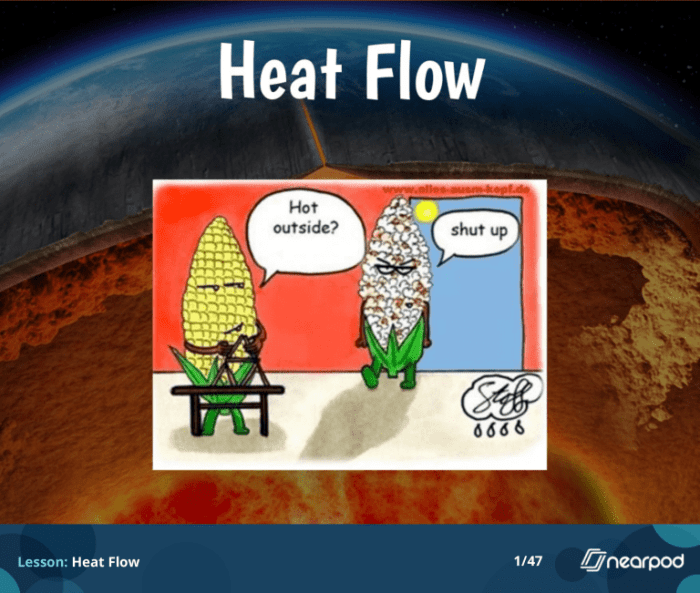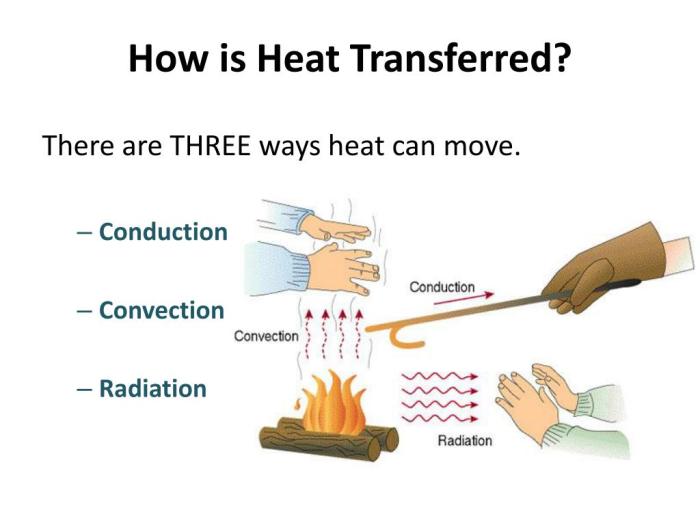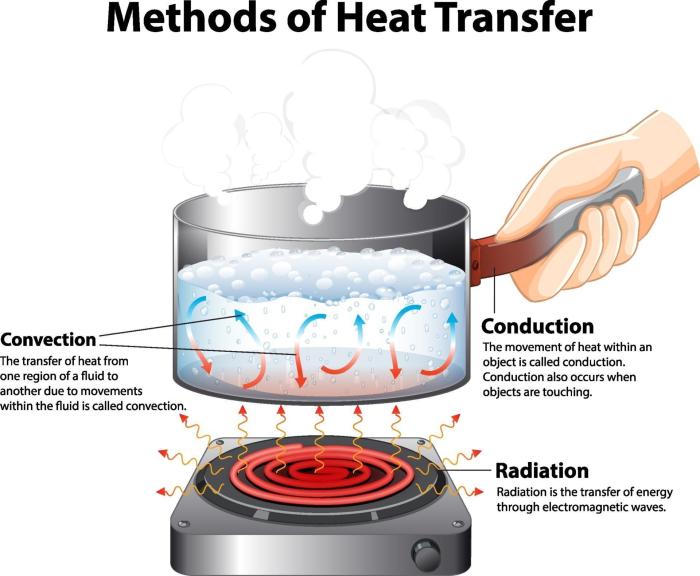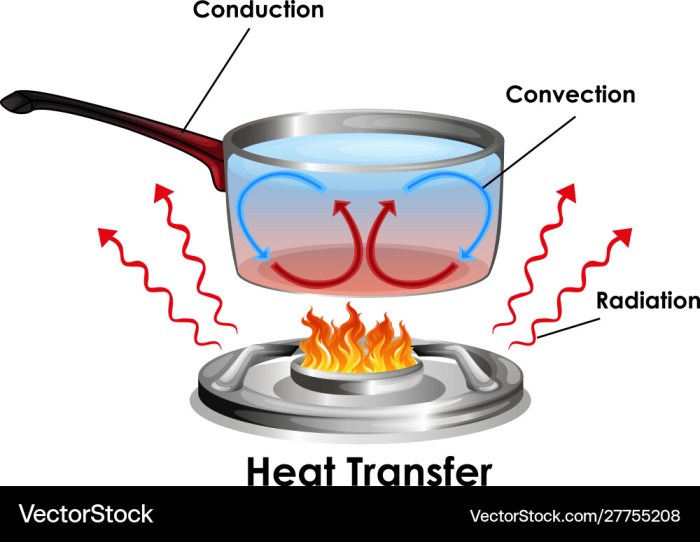Nearpod: Heat Transfer & Conduction transforms science education, providing an engaging and interactive learning experience that empowers students to grasp complex concepts with ease. This module seamlessly integrates interactive lessons, simulations, assessments, and collaboration tools, creating a dynamic and personalized learning environment that fosters student success.
With Nearpod’s Heat Transfer & Conduction module, educators can harness the power of technology to bring abstract scientific principles to life. Interactive simulations allow students to visualize and manipulate heat transfer processes, making learning more engaging and meaningful. Comprehensive assessments and personalized feedback empower teachers to monitor student progress and tailor instruction to individual needs.
Definition of Nearpod: Heat Transfer & Conduction

Nearpod’s Heat Transfer & Conduction module is an interactive and engaging resource designed to enhance the teaching and learning of heat transfer concepts in science classrooms.
This module provides students with a comprehensive understanding of the principles of heat transfer, focusing on the conduction mode. It includes interactive simulations, videos, quizzes, and other activities that help students visualize and explore the processes involved in heat transfer through conduction.
Key Features
- Interactive Simulations:Nearpod’s simulations allow students to manipulate variables and observe the effects on heat transfer in real-time, fostering a deeper understanding of the concepts.
- Engaging Videos:The module includes high-quality videos that demonstrate heat transfer principles in various contexts, making the learning process more engaging and relatable.
- Formative Assessments:Quizzes and other assessment tools within the module provide teachers with insights into student understanding and identify areas where additional support may be needed.
- Collaboration Tools:Nearpod encourages collaboration among students through features like student-paced activities and shared notes, promoting peer learning and knowledge sharing.
- Teacher Dashboard:Teachers have access to a dashboard that provides real-time data on student progress, allowing them to monitor student understanding and adjust their teaching strategies accordingly.
Interactive Lessons and Simulations
Nearpod offers an array of interactive lessons and simulations that captivate students and foster a more engaging learning experience. These resources leverage a blend of visual aids, interactive elements, and simulations to make abstract concepts relatable and immersive.
These lessons and simulations cater to diverse learning styles and cater to different classroom settings. For instance, a lesson on thermal conductivity could incorporate interactive simulations that allow students to manipulate variables and observe the resulting changes in heat flow.
Such hands-on experiences reinforce understanding and make learning more meaningful.
Interactive Lessons
Interactive lessons within Nearpod’s Heat Transfer & Conduction module provide a dynamic learning environment. These lessons incorporate videos, images, polls, and quizzes to keep students actively engaged. By integrating interactive elements, students can assess their understanding in real-time and receive immediate feedback.
Simulations
Nearpod’s simulations offer a virtual laboratory experience, enabling students to conduct experiments and explore concepts in a safe and controlled environment. These simulations allow students to manipulate variables, observe the outcomes, and test hypotheses without the need for physical equipment.
For example, a simulation on convection currents could allow students to adjust the temperature and viscosity of a fluid to observe how these factors influence heat transfer.
Assessment and Feedback

Nearpod provides a robust suite of assessment and feedback features that empower teachers to effectively track student progress and deliver personalized feedback.
These features enable teachers to create a variety of assessments, including:
Quizzes
- Multiple-choice questions
- True/false questions
- Short answer questions
- Essay questions
Polls
Polls allow teachers to gauge student understanding and gather feedback quickly.
Exit Tickets
Exit tickets are short assessments that students complete at the end of a lesson to assess their comprehension and identify areas where they need additional support.
Nearpod’s feedback tools allow teachers to provide timely and specific feedback to students, both during and after lessons. This feedback can be delivered in a variety of formats, including:
Written Comments
Teachers can provide written comments on student work, offering praise, suggestions for improvement, or additional resources.
Audio Feedback
Teachers can record audio feedback to provide students with more personalized and engaging feedback.
Video Feedback
Teachers can record video feedback to provide students with visual demonstrations and explanations.
By leveraging Nearpod’s assessment and feedback features, teachers can gain valuable insights into student learning, identify areas where students need additional support, and provide timely and personalized feedback to help students succeed.
Collaboration and Student Engagement

Nearpod’s collaborative learning environment fosters student engagement and interaction through various tools and features. These tools enable students to actively participate in lessons, share ideas, and collaborate with peers.
Interactive Whiteboard
The interactive whiteboard allows students to collaborate in real-time by adding notes, drawings, and images to shared slides. This tool promotes peer learning and encourages students to contribute to discussions and share their perspectives.
Group Discussions
Nearpod facilitates group discussions by dividing students into smaller groups for focused collaboration. Students can engage in text-based discussions, share ideas, and work together to complete tasks. This feature fosters teamwork, communication skills, and critical thinking.
Polls and Quizzes
Interactive polls and quizzes engage students by allowing them to respond to questions and provide feedback. These tools can be used to assess student understanding, stimulate discussion, and promote friendly competition.
Student Pacing
Nearpod’s student pacing feature allows students to progress through lessons at their own pace. This flexibility enables students to engage with the material at a comfortable speed, reducing frustration and promoting self-directed learning.
Integration with Other Resources
Nearpod’s Heat Transfer & Conduction module seamlessly integrates with various educational resources to enhance the learning experience.
This integration offers several benefits, including access to a wider range of content, customization options, and improved collaboration opportunities.
Specific Integrations
- Google Classroom:Nearpod integrates with Google Classroom, allowing teachers to assign Nearpod lessons and track student progress within the Classroom interface.
- Khan Academy:Nearpod provides access to Khan Academy videos and exercises, enabling teachers to incorporate interactive video content into their lessons.
- Flipgrid:Nearpod’s integration with Flipgrid allows students to record and share video responses to discussion prompts and assignments.
Case Studies and Success Stories

Nearpod Heat Transfer & Conduction has been successfully implemented in numerous classrooms, leading to significant improvements in student learning outcomes. Teachers have reported that the module’s engaging and interactive lessons, simulations, and assessments have helped students develop a deeper understanding of heat transfer and conduction.
One notable case study is a high school physics teacher who used Nearpod to teach a unit on heat transfer. The teacher found that students who used Nearpod performed significantly better on assessments than those who did not. Additionally, students reported that they enjoyed the Nearpod lessons and found them to be more engaging than traditional lectures.
Strategies and Techniques
Teachers who have successfully implemented Nearpod Heat Transfer & Conduction have employed a variety of strategies and techniques to enhance student learning.
- Interactive Lessons:Teachers have found that the module’s interactive lessons are a great way to engage students and help them learn. These lessons include a variety of activities, such as polls, quizzes, and simulations, that keep students actively involved in the learning process.
- Simulations:The module’s simulations are another valuable tool for teaching heat transfer and conduction. These simulations allow students to explore different concepts in a safe and interactive environment. For example, students can use the simulations to investigate how different materials conduct heat or to observe the effects of different temperatures on heat flow.
- Assessments:Nearpod Heat Transfer & Conduction includes a variety of assessments that can be used to track student progress and provide feedback. These assessments include quizzes, polls, and open-ended questions. Teachers can use these assessments to identify areas where students need additional support and to provide targeted feedback.
Quantitative Data
There is a growing body of quantitative data that supports the positive impact of Nearpod Heat Transfer & Conduction on student learning outcomes. One study, conducted by a university researcher, found that students who used Nearpod performed significantly better on a standardized test of heat transfer concepts than students who did not use Nearpod.
Another study, conducted by a high school teacher, found that students who used Nearpod were more likely to pass a unit test on heat transfer than students who did not use Nearpod. The teacher also found that students who used Nearpod reported that they felt more confident in their understanding of heat transfer.
Best Practices for Implementation

Integrating Nearpod’s Heat Transfer & Conduction module into classroom instruction requires careful planning and effective implementation strategies. By following best practices and addressing potential challenges, educators can maximize the module’s potential and foster student engagement.
To ensure successful implementation, consider the following:
Planning and Integration
- Align with Learning Objectives:Clearly define the specific learning objectives the module will address, ensuring alignment with curriculum standards.
- Integrate into Lesson Plans:Plan the module’s use within a broader lesson sequence, providing context and connections to other learning activities.
- Scaffold Learning:Introduce the module gradually, providing opportunities for students to build foundational knowledge before engaging with more complex concepts.
- Use as a Supplement:Utilize the module as a complementary resource, not a substitute for hands-on experiments or traditional instruction.
Troubleshooting
- Technical Issues:Ensure devices and internet connections are functioning properly. If problems arise, contact Nearpod support or consult online troubleshooting guides.
- Student Engagement:Monitor student participation and adjust the pace or activities as needed. Encourage active involvement and provide opportunities for questions and discussions.
- Assessment:Use the module’s built-in assessment tools to monitor student understanding. Provide feedback and address any misconceptions promptly.
Future Developments and Innovations: Nearpod: Heat Transfer & Conduction

Nearpod’s Heat Transfer & Conduction module is poised for continued evolution, driven by emerging trends in educational technology and the changing needs of educators and students.The module may incorporate virtual and augmented reality (VR/AR) to provide immersive learning experiences. VR simulations could allow students to explore heat transfer phenomena in real-world environments, while AR overlays could enhance understanding of complex concepts by superimposing interactive content onto physical objects.
Emerging Trends in Educational Technology
The rise of artificial intelligence (AI) and machine learning (ML) holds promise for personalized learning experiences. AI-powered chatbots could provide real-time support to students, while ML algorithms could analyze student data to identify areas for improvement and tailor instruction accordingly.The
growing popularity of mobile learning presents opportunities for increased accessibility and engagement. Nearpod’s module could be optimized for mobile devices, allowing students to learn on the go and access interactive content anywhere, anytime.
Adapting to Changing Needs, Nearpod: heat transfer & conduction
The module may adapt to incorporate emerging scientific discoveries and technological advancements in heat transfer and conduction. This could include integrating research on novel materials, innovative heat transfer techniques, and the latest industry practices.As educators strive to foster collaboration and critical thinking, the module could include more opportunities for students to engage in group discussions, problem-solving activities, and project-based learning.By
embracing these future developments and innovations, Nearpod’s Heat Transfer & Conduction module will continue to provide educators and students with cutting-edge learning experiences that meet the evolving demands of the 21st-century classroom.
Quick FAQs
What is Nearpod: Heat Transfer & Conduction?
Nearpod: Heat Transfer & Conduction is an interactive learning module designed to enhance science education by providing engaging lessons, simulations, assessments, and collaboration tools.
How does Nearpod: Heat Transfer & Conduction benefit students?
Nearpod’s interactive lessons and simulations make learning more engaging and meaningful, while assessments and personalized feedback help students track their progress and improve their understanding.
What are the key features of Nearpod: Heat Transfer & Conduction?
Key features include interactive lessons, simulations, assessments, collaboration tools, integration with other resources, and ongoing development based on educational trends.